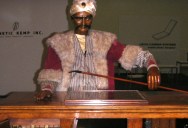The “Mechanical Turk” Chess Machine Completely Fooled Napoleon, Benjamin Franklin And Many Others Into Believing It Was Real
At this point in AI development, it’s not odd to think about a computer that’s so good at chess it could beat the best players in the world.
Heck, IBM built an AI program that beat the best (Garry Kasparov) all the way back in 1997.
Back in the 18th century, though, it would have been quite the feat indeed. In 1770, Wolfgang von Kempelen showed off a chess “machine” that could defeat some pretty skilled players indeed.

He unveiled his machine to the Empress Maria Theresa of Austria, and it consisted of a large cabinet he claimed was filled with cogs and other mechanical parts, a chess board top, and a mechanical clockwork humanoid to shift the pieces.
Von Kempelen would turn the cabinet to show that it contained nothing but the machinery, and then would lift the “robot’s” clothes to prove it was what he claimed, before winding it up like a clock.
Then, it began to move pieces around the board.
Empress Maria Theresa was impressed, but others in the audience were more skeptical, expecting that some sort of trickery was at play.
A tour of Vienna turned into a tour of Europe, and it wasn’t long before the “Mechanical Turk” was playing against (and beating) some serious celebrities – Napoleon Bonaparte, Charles Babbage, and Benjamin Franklin, to name a few.

Though more than a few people were sure it was a hoax, others took the ” machine” at face value. Either way, no one knew exactly how it worked.
The “machine” won a lot of games but it wasn’t undefeated. Chess experts were able to best the “Mechanical Turk,” which knew the rules and played tactically.
It played, well…like a decent chess player crammed inside a cabinet.
Which is exactly what it turned out to be.
The son of the machine’s final owner finally revealed the truth in a series of Chess Monthly articles in 1857, stating that magnetic pieces were operated by a chess player inside the cabinet.

Dan Flannigan, author of Legend and Lore: Jefferson Medical College, described the hoax in his book.
“To execute the Turk’s moves, the payer engaged a pantograph, which positioned the Automaton’s mechanical arm over the playing board and operated its grasping hand. In the center of each square of the hidden chess board, a hole had been drilled to receive the point of the pantograph. By inserting this point into the desired location, the player could execute his moves without being in visual contact with the actual playing board.”
Sure, it might be more impressive to think it was an early form of AI.
But honestly, the player inside deserves credit for winning chess games crammed into a box and using a board that’s inverted from the one most of us use.
Thought that was fascinating? Here’s another story you might like: Why You’ll Never See A Great White Shark In An Aquarium

Sign up to get our BEST stories of the week straight to your inbox.




